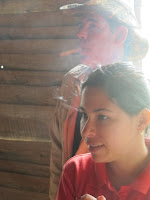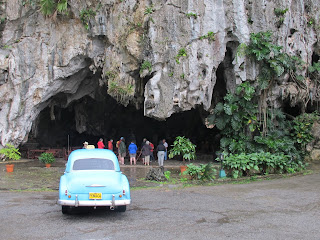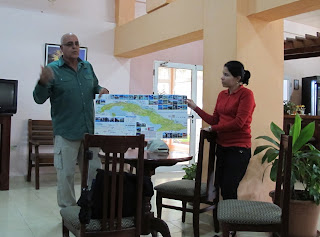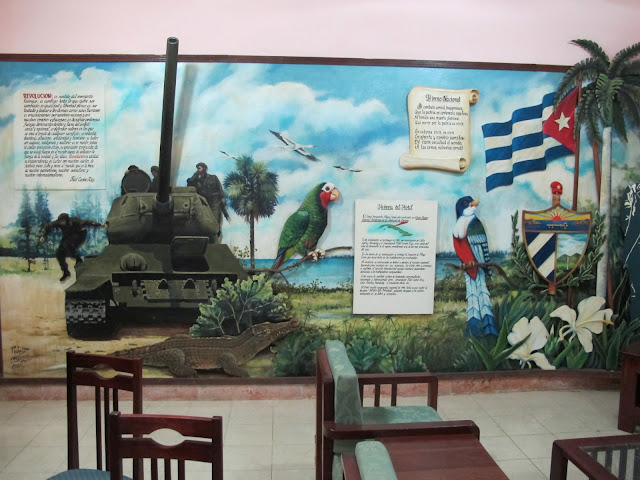Friday, March 1
 |
| Tobacco drying in a barn in Vinales, Cuba |
 |
| Yuli in a cloud of cigar smoke |
Today we visited a tobacco farm, where we met the farmer. Since it was rainy and overcast, the farmer
took us inside his drying barn where he explained tobacco farming through our
noble guide and translator, Yuli. Of course the
farmer, who Joan thought looked like Antonio Banderas, was doing a terrific job
smoking one of his cigars. We thought we were going to lose our Yuli in the
cloud of smoke, but she soldiered on.
 |
| Showing us how to roll a cigar. |
A group of us (not Joan) purchased a bundle from “Antonio,” and later when smoking them, we could see how some were better constructed than others in the batch by the draw of the smoke.
 |
| Cigars rolled and pressed for us in Cuba. |
 |
| David enjoying a hand-rolled Cuban cigar |
Though nice, these cigars did not compare to
the fancy ones we got in Habana, especially for the draw. We might add that the farmer’s bundle, cost
about $2 each, and the fancy ones cost $8
to $10 each and would be about $25 in  |
| Mogotes near Vinales in Cuba. |
After the farm, we drove into the Parque Nacional Vinales, an area of very interesting rock formations, called mogotes, very similar to those found in China
Unfortunately it was still drizzling and the clouds were low, so we did not have the opportunity to see the scenery in all it's spectacular grandeur, but we think our pictures evoke drawings of similar landscapes in China.
 |
| Entrance to Palenque de los Cimarrones |
There are several
well-known caves in the rock formations that have become popular places for tourists
to visit. Most of our group visited one
cave, called Palenque
Our next spot was the Mural de la Prehistoria, where we had lunch. There were
three choices . . . and great mjiotos and pina coladas and beer! This dining area was in full view of the mural,
a huge garish painting done right on the side of one of these interesting
formations in the 1960s by a follower of Diego Rivera. The huge snail, dinosaurs, sea monsters and
humans represent an artistic vision of evolution, all in psychedelic colors. It attracts a lot of tourists to the little
restaurant.
 |
| The psychedelic Mural de la Prehistoria near Vinales, Cuba |
 |
| Disconcerting doll head |
 |
| At the Jardin de Caridad, Vinales, Cuba |
After lunch, we headed into the town of Vinales
 |
| At the Jardin de Caridad, Vinales, Cuba |
Then we walked around the town of Vinales, trying to mingle with the locals. (We stood
out).
There were a couple of small art galleries, a common thread in Cuba
There was a small queue in front of the Government store. Cubans go here to buy many staples – if they have them. Interesting retail – no displays, not even stock showing, whatever. I guess you just have to ask, and if they have it, you can get it for a fixed price. It is almost as bad as the Pennsylvania State Liquor Store system in the 1970s – but this is for staples, not evil spirits.
 |
| Street food: Meringues and chocolate donuts! |
There was a small queue in front of the Government store. Cubans go here to buy many staples – if they have them. Interesting retail – no displays, not even stock showing, whatever. I guess you just have to ask, and if they have it, you can get it for a fixed price. It is almost as bad as the Pennsylvania State Liquor Store system in the 1970s – but this is for staples, not evil spirits.
 |
| Town square in Vinales, Cuba with the obligatory statue of Marti |
Of course there is always the black market. We asked our guide Yuli
about this – where is the black market?
Everywhere she said, as she gestured with a sweep of her arm-- it’s
pervasive, all over Cuba Miami
Airport
Dinner was back at the hotel, and this was the first time that we saw
musicians that were a bit of a disappointment; they didn’t seem as polished as the
others we had seen.
There were some cute cats up in the tree just off the
dining porch, that, though perched high (to avoid the dogs probably), knew how
to work the crowd, especially Joan, who was a soft touch. We had three choices
for dinner…and afterwards didn’t sit around the pool, as it was cold and we
were all bundled in all the warm clothes we’d brought with us. Steve did teach us about the warming
qualities of aged rum though, and we found it was a good antidote to the chill.
Saturday, March 2
After another buffet breakfast at the hotel, we departed Vinales and
headed for the Zapata Peninsula
This trip involved quite a bit of highway driving and was our longest
day in the bus. Cuban highways are not
too busy for the simple reason that not a lot of people have cars. The busses
are not new but rather well used, which is polite-talk for almost always
crowded. In the countryside, in lieu of
busses, we saw old trucks fitted with benches that were also overflowing. There is another time-honored system of
getting around in Cuba
 |
| Hotel Playa Larga individual room-a great cottage! |
We arrived at the Hotel Playa Larga to find our rooms were actually
separate buildings, small art-deco cottages about the size of the average Cuban
house (which are small by our standards). That reminded us of 1940s suburban
housing developments in America
Our first appointment was with Frank Medina, the director of Cienega de Zapata National Park. He explained that Cuba
 |
| Cienega de Zapata National Park Director with our guide Yuli. |
Cuba has 290 natural beaches, including
our Playa Larga, and about 100 protected areas.
The island Zapata
National Park Cuba
 |
| Mural at Hotel Playa Larga on the Bay of Pigs, Cuba |
The area also has a problem with invasive species; about the only ones
they were really successful in eradicating were the freedom fighters sponsored
by the CIA who came into the Bay of Pigs in
1961. Yuli tells us that one of the
reasons the invasion, which Cubans call LaVictoria de Playa Giron, failed was the
freedom fighters expected support from
the local inhabitants. But in the years between Castro’s revolution in 1958 and
the invasion in 1961, the Castro Communist government steered education and
health care resources to the countryside the locals had not seen during the
Batista years. She said that most of the
locals decided they were better off under Castro.
 |
| Monument to a fallen Cuban defender at the Bay of Pigs |
Throughout the area, we saw monuments
to the soldiers who died in that battle, and the hotel had quite a 3-D wall
mural giving their side of the battle.
We were disappointed not to have the chance to visit the museum about
the invasion at Playa Giron, which we learned was very interesting.
Before dinner, we went for a walk on the beach and rocky shoreline,
which was overflowing with flotsam and jetsam, but we spotted some starfish,
lots of sea urchins and sweet striped fish in the shallow tidepools.
 |
| Tidepooling at Playa Larga on the Bay of Pigs |
Some of us (even Dane!) donned our swim suits
and went for a swim in the Bay of Pigs . It was
very shallow at Playa Larga, so we could wade out for many yards and only have
the warm water come up to our waists.
 |
| Swimming (well, waltzing) in the Bay of Pigs |
 |
| Seeing the sun come out on Playa Larga Cuba after several days of clouds.
|
And glory
be, the setting sun poked its way through the clouds and we were hopeful for
improved weather after several days of grey skies, drizzle and cold.
Dinner, again with good live musicians, was fine. One of the things about the Cuban menu is that the plates become a “study in white,” rice, potato, pork chop, chicken or fish . . . .and surprise, it’s lovely rice pudding for dessert again!
 |
| "It's lovely rice pudding for dinner again |
 |
| The evidence of a night well smoked. |




No comments:
Post a Comment